Probe assembly with rotary tip
a technology of rotary tip and probe, which is applied in the direction of electrical testing, measurement devices, instruments, etc., can solve the problems of reducing the operation rate of the inspection apparatus, reducing the reliability of inspection, and significantly difficult to remove only the thin oxide film, so as to reduce the damage to the pad and ensure the connection. reliable
- Summary
- Abstract
- Description
- Claims
- Application Information
AI Technical Summary
Benefits of technology
Problems solved by technology
Method used
Image
Examples
first embodiment
[0042]FIG. 1 is a side view of a probe assembly according to a first embodiment of the invention. FIGS. 2A, 2B, 3A and 3B are side views illustrating the general operation of the present probe.
[0043]As shown in FIG. 1, the probe has a link structure with a parallel spring 1. Upper and lower sides of the link structure are parallel beams 1a and 1b, respectively. An end of the link structure is formed as a vertical probe portion 1c, and a base end portion of the link structure is formed as a fixed end 3. These components altogether form a Z-deforming portion 31. A support arm 32 is provided to extend from the vertical probe portion 1c. The support arm 32 includes a tip contact element 5 at an end thereof, and a displacement absorbing portion 33 in a middle area thereof. In the example of FIG. 1, the displacement absorbing portion 33 is formed in an inverted U-shape, but it may alternatively be formed in a U-shape. When the tip contact element 5 is displaced (moved) vertically, the dis...
second embodiment
[0056]FIGS. 6A, 6B and 7 illustrate a probe assembly according to a second embodiment of the invention. FIGS. 8A to 8C illustrate operation of the present embodiment. In FIGS. 6A and 6B, a cleaning sheet 7 is disposed with a rough surface 7a contacting with the tip contact element 5. An exemplary structure of the cleaning sheet 7 is shown in FIG. 7, which may be obtained in the following manner. In a resin sheet, openings are provided through which probes are to be inserted. A cantilever cleaning sheet 71 is provided on one side of the opening. Fine particles such as diamond particles are applied to the surface of the cleaning sheet 7 where it abuts the tip contact element 5. The cleaning sheet 7 is disposed such that an end of the rough surface 7a abuts a portion of the tip contact element 5. As the tip contact element 5 rotates, the tip contact element 5 and the rough surface 7a are displaced relatively, and rub against each other.
[0057]Referring to FIGS. 8A to 8C, the operation o...
third embodiment
[0060]FIGS. 9A and 9B illustrate a tip contact element of a probe according to a third embodiment of the invention. The tip contact elements of the first and second embodiments may also be serrated as shown in FIGS. 9A and 9B. The serrated shape, in combination with a rigidity design, of the tip contact element promotes destroying the oxide film. With this structure, a more preferred rubbing amount may be determined.
PUM
 Login to View More
Login to View More Abstract
Description
Claims
Application Information
 Login to View More
Login to View More - R&D
- Intellectual Property
- Life Sciences
- Materials
- Tech Scout
- Unparalleled Data Quality
- Higher Quality Content
- 60% Fewer Hallucinations
Browse by: Latest US Patents, China's latest patents, Technical Efficacy Thesaurus, Application Domain, Technology Topic, Popular Technical Reports.
© 2025 PatSnap. All rights reserved.Legal|Privacy policy|Modern Slavery Act Transparency Statement|Sitemap|About US| Contact US: help@patsnap.com



